In this guest post, Californian cyclist Frank Brockmann relives the experience of conquering Haleakala and provides some tips for cyclists who are keen to tackle the epic climb up this dormant volcano.
Haleakala is arguably one of the world’s premiere routes for climbing cyclists. The numbers don’t lie: with 10,000+ feet (3,000+ metres) of vertical gain over just 36 miles (57km) of roadway, this is simply a big, giant, honking climb … but there’s also a fair amount of man-made cycling-hype to go with all that volcanic hugeness. The website for the annual Cycle to the Sun race, for example, offers up the ride as nothing less than a big ol’ dare:
‘Ride The Longest, Steepest Paved Road On Earth.’
I’m not inclined to fact-check these kinds of claims, but true or not, I get the message: Huge climb here. World-class. Way up there. Bring it on.
On paper, the climb has a kind of mathematical purity and smoothness. The total vertical gain is both impressive and unique (there just aren’t that many 10,000ft climbs around, no matter where you hang your helmet), and the slope is constant and manageable (it has an average gradient of 5.5% and rarely gets above 8%).
Overall, it’s a perfect recipe for weekend warrior appeal, something that makes recreational cyclists say: ‘Hey, I’m doing pretty well on Big Dog Hill during the weekly club ride, so I should go tackle this volcano on the day before the big luau!’
Big, giant climb? Yes. Impossibly steep? Not so much. Still, I’m sure many cyclists who set out to conquer this climb end up turning around well before reaching the summit.
Why? Well, consider this: according to Wikipedia — which is never ever wrong about anything, ever — early Hawaiians gave the mountain the name Haleakala, which means ‘house of the sun’. The crater at the summit was home to the grandmother of Maui (the demi-god after whom the island is named).
If true, this proves to me that early Hawaiians also possessed a keen sense of humor with regard to future cyclists. If you don’t plan for cold air, this ‘house of the sun’ grandma can chill your junk out faster than a pound of shaved ice stuffed between your shorts and your saddle.
So what’s the climb like? Well, I reckon it makes sense to break it into three parts. Here’s the breakdown of each:
Part A
There are a few ways to start the ride to Haleakala: from the town of Paia, or Kehei, or wherever you happen to be staying. Truthfully, there’s really only one respectable way to end it. More on that soon.
The town of Paia earns my vote for the ‘true’ start point, because that’s where the 4-6% grade really begins. By contrast, if you depart from the town of Kehei you’ll start with up to 10 miles (16km) of flat highway spinning through charming, breezy fields of sugar cane. Even though the 20mph (32km/h) winds, the mai tai hangover and the 23-year-old local phenom cyclist you’re trying to draft behind might cause you to burn a few matches, none of that stuff really counts as climbing and you know it.
So for the sake of climb-loving cyclists everywhere let’s just make it official: the Haleakala climb starts at sea level in Paia. Period. It ends at the summit, where the dirt turns red and pavement runs out and there’s no more ‘up’ to ride. Period.
First things first: parking in Paia is a cutthroat affair. If you get there early, you’ll find a free parking lot near the corner of State Highway 36 and Paia Mini-Bypass Road. If that lot is full and it’s 9:00am on a Saturday or Sunday, you might want to just start praying like hell that someone in the nearby restaurant will eat a quick breakfast, pass gas, and cough up a parking space. Alternatively, there is at least one paid parking lot nearby, so not all hope is lost. But again, you can’t say you weren’t warned.
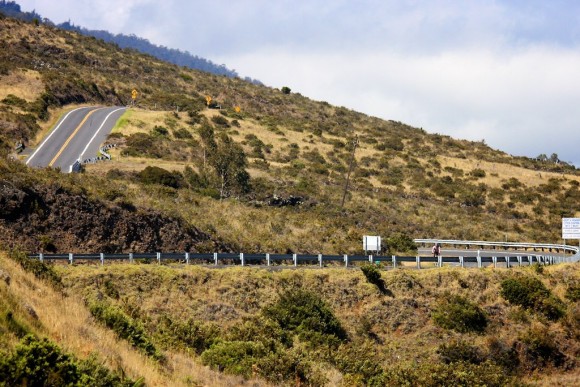
No matter where you park, you’ll start the ride somewhere near the corner of State Highway 36 and Baldwin Avenue by turning on to Baldwin toward Haleakala (away from the ocean). The road quality is pretty rough as you make your way out of town, and I don’t remember any bike lane to speak of. At least you’re climbing, though, and within minutes you’ll be sweating too, regardless of how hard you’re working; it’s humid. Good times.
You follow Baldwin for almost 7 miles (11km) to the town of Makawao. It’s fairly interesting along the way: a stone church, fields of sugar cane, abandoned sugar mills, schools, graveyards, glass shops. You get a sense of what life was like 50 to 100 years ago here, and how locals would have perceived you as a stupid, clownish figure as you pedaled along in your yellow-glow Pearl Izumi skin-tight butt-huggers on your way to the center of a dormant volcano. Mainland fools!
In Makawao, you dodge a few cars and then cross the main intersection on to Olinda Road. Here, you get a brief taste of 10% grade for about 300 feet (100 metres), but it levels off and you put Makawao in your rearview mirror, metaphorically speaking, as you pedal away from town toward the mustangs and the eucalyptus groves.
(Note: there’s a well-documented, easy-to-miss right turn on to Hanamu road at the 8 mile (13km) mark of the ride. Miss the turn and you’ll be sorry. Really sorry.)
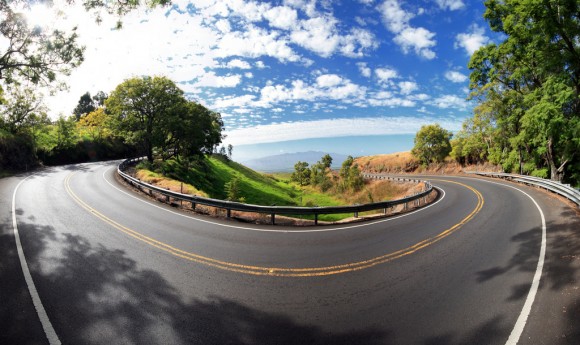
Part B
For me, this is where the climb gets interesting. About 9 miles (14.5km) into the ride, you get a wholly decent bike lane and you converge with State Highway 177. The semi-inhabited ranch areas give way to miles of nicely paved switchbacks. You start to climb above the terrain. If you’re not in a cloud (literally), stunning views of the island begin to emerge. Near Crater Road at mile 14 (22.5km), there are a couple of little markets — the last of which is Sunrise Market (elevation 3,500ft/1,070 metres).
Away from Sunrise Market, it makes sense to settle into a rhythm. On my ride, at the first switchback a local roadie wheeled up beside me, radio blaring some 80s music into the countryside. Then, he uttered ‘Good luck–this is where it gets hard!’ before spinning away ahead of me.
From there, I counted about 20 switchbacks, none of which was devastating by itself, but he was right — the cumulative effect was impossible to ignore. Major quad-burner. After an hour I started having paranoid thoughts about not having enough food in my gut to fuel the effort, so at 21.5 miles (34km) and 6,000ft (1,830m) of altitude I pulled into a scenic turnout, took out a Clif bar, and nearly finished off my water just washing it down. Then I did something really dumb: I struck up a conversation with a couple of tourists.
‘There’s more water just up the road there’, they said. They were extremely nice people and I ignored the cardinal rule of cycling in a new environment: never believe what locals tell you in regard to how far something is from your current location. They are always, always wrong, and the water is never, ever ‘just up the road’.
It took me about 40 minutes to reach the Visitor Center, half of which was spent cursing at that nice couple from San Diego every time I looked at my empty water bottle.
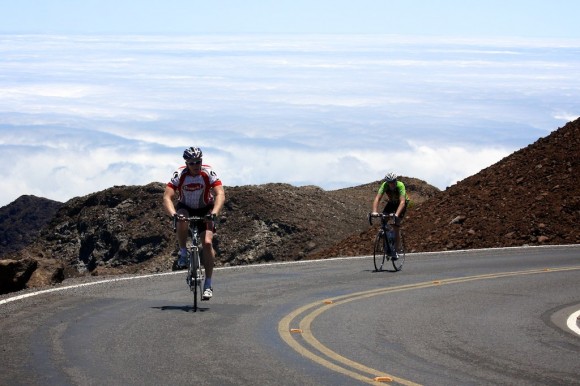
Part C
So, here’s what happens when you don’t bring your warm clothes to Haleakala: at 7,000ft (2,130m) you reach the Visitor Center, where you give $5 to the park ranger. You use the bathroom, fill your bottles, eat something, and glug some water. You try stretching your legs a bit. Then you get back on the bike, and after about 30 seconds the little voice in your head says something like:
‘Wow, it’s fricken cold up here. Maybe I’ve had enough. After all, 7,000 feet of climbing is pretty good.’
Don’t be that guy. The most unique thing about the Haleakala, other than the sheer size of it, is the way conditions can vary so much between the bottom and the top. Wherever that extra clothing is — on your body, in your pockets, tied to your frame, whatever — you’ll be using it pretty soon.
Leaving the Visitor Center, the landscape becomes decidedly lunar. The day of my ride, the winds kicked up in all directions but for some reason (thin air?) I never really felt pushed around by the wind or breathless from the elevation. If it’s cloud-free up there, the views can be truly amazing, which helps pass the time. Otherwise, there’s not much to do but press on and forget about the fact that the average grade kicked up to about 8%.
Soon, you’re at 8,000ft (2,440m). Then, you roll up to the sign for 9,000ft (2,740m). It just kind of happens. Just a couple more miles to go. How could anyone turn back at this point? The observatories are in sight. You just keep going.
There’s a main parking lot near the summit, which looks like the ideal place to stop. But as you roll up to it, you see another road that continues up to the true summit. Kind of steep, maybe 15% in places. Sure, you’re tired. But what are you gonna do, not go up there?
You just have to ride up to the overlook, get off the bike, and have someone take your picture next to the elevation sign. And don’t be surprised if a lot of the tourists treat you like a rock star.
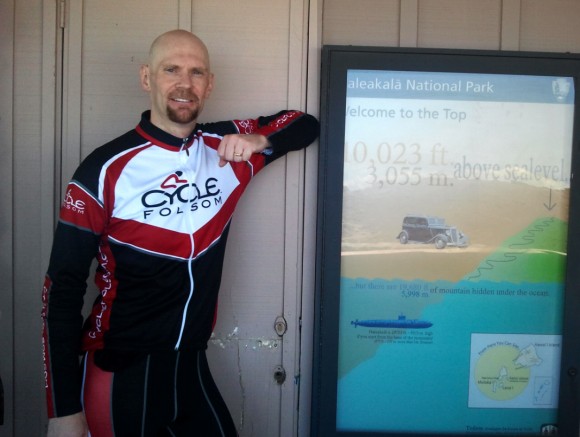
At the summit, all of the moaning about warm clothing will start to make sense. If you felt a chill coming up to the summit, it’s nothing compared to what you are about to feel going back down. Get the gloves out, and put on all that warm stuff you humped up to the summit with you. That way, you can really enjoy a killer descent. If you’re lucky, you won’t even get stuck behind a pokey motorist on the way down.
Side note: the descent rolls pretty fast in some areas, and I was almost killed by a pheasant on the way down. But that’s another tale. Just be careful.
Here’s the bottom line. Assuming you’ve got the required endurance and at least half a day to kill, Haleakala really only requires two things: patience and warm clothing.
Patience:
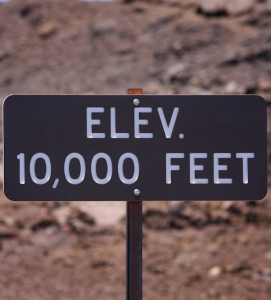 Obviously, it’s a long climb. Hours in the saddle. Even though none of it is very steep, there are almost no flat or downhill sections at all, and chances are pretty good that’s not your everyday club experience. If you’re not used that, you’ll be feeling it.
Obviously, it’s a long climb. Hours in the saddle. Even though none of it is very steep, there are almost no flat or downhill sections at all, and chances are pretty good that’s not your everyday club experience. If you’re not used that, you’ll be feeling it.
How long does the climb take, you ask? Well Ryder Hesjedal holds the record with 2 hours and 32 minutes. Average Joes do it in 5, 6, or more. But seriously, does it really matter? It only matters if you’re not used to sitting for that long. (And hey, if you’re shooting for the KOM on Strava, you should know that your stopped time is counted as moving time.)
Warm clothing:
I think it’s the weather, not the lack of patience, which usually does people in, even when they know better. When you roll out from the town of Paia at 7am, and it’s a balmy 81°F (27°C) and there’s a slight breeze coming off the ocean, and you’re picking up the scent of powdered sugar on fresh waffles as it wafts over from the nearby cafe, and your legs are dancing like they can’t wait to kick all 10,000 feet of that volcano’s ash, well … if at this point you haven’t brought warm clothing of any kind, you might just be toast.
Why? Because when you’re mentally rehearsing how you’re going to lift that bike over your head for your Instagram moment at the summit, you’re probably not going to follow through on thoughts like ‘oh crap — I forgot my full-fingered gloves’ or ‘damn, I really should have carried along that extra wool base layer.’ Nope. Corrections of this kind aren’t going to happen, even if you actually brought that stuff along. Which you didn’t, because it’s 81°F, and you’re a climber, dammit.
Right?
Just bring the warm stuff, even if you don’t think you’ll need it!
Have you got a climbing story you’d like to share? Perhaps you’ve just conquered one of the legendary climbs in the French Alps. Or maybe you’ve finally finished that pesky local climb after three attempts. Or maybe you’ve just completed your very first climb. We’d like to hear from you. Send an email to Matt with all the details.
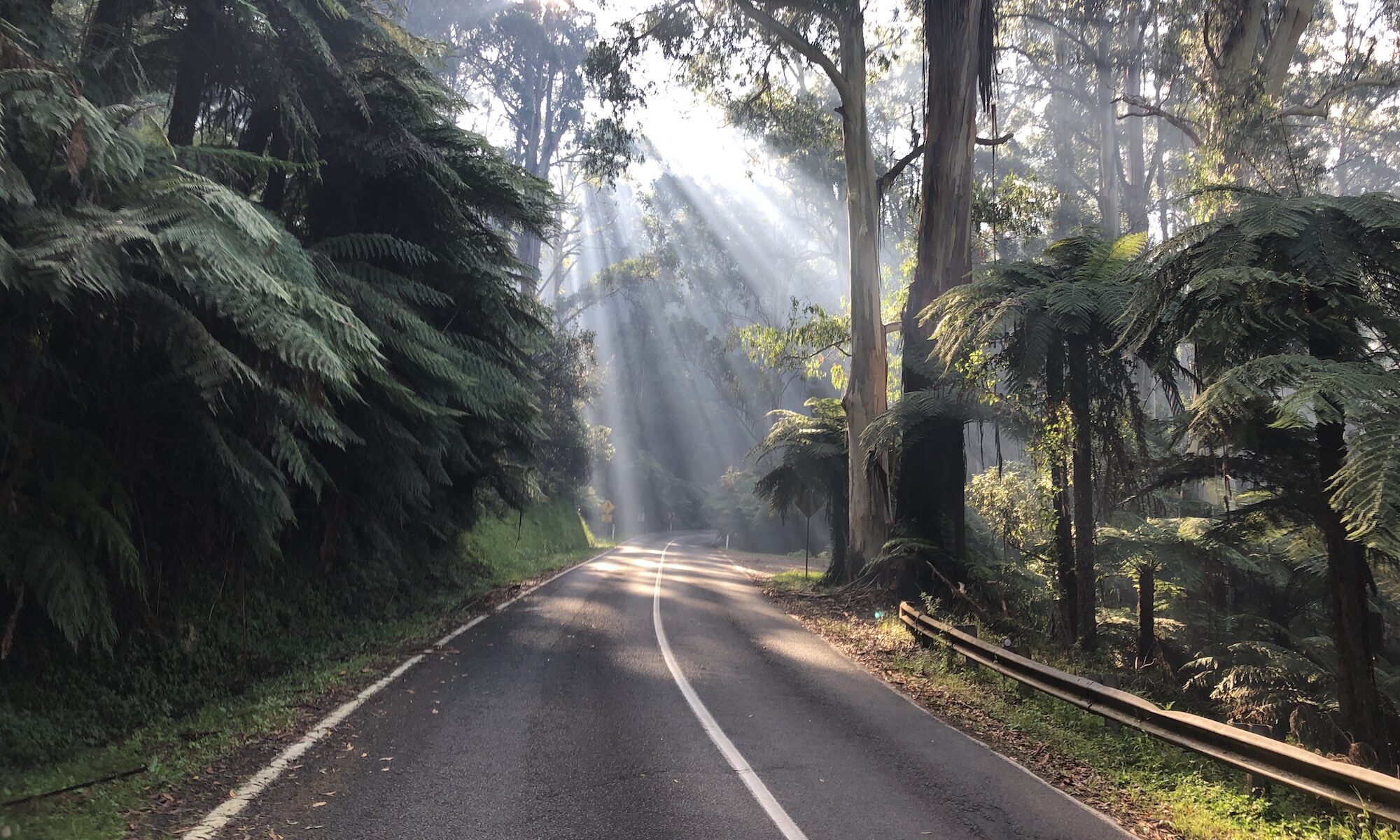
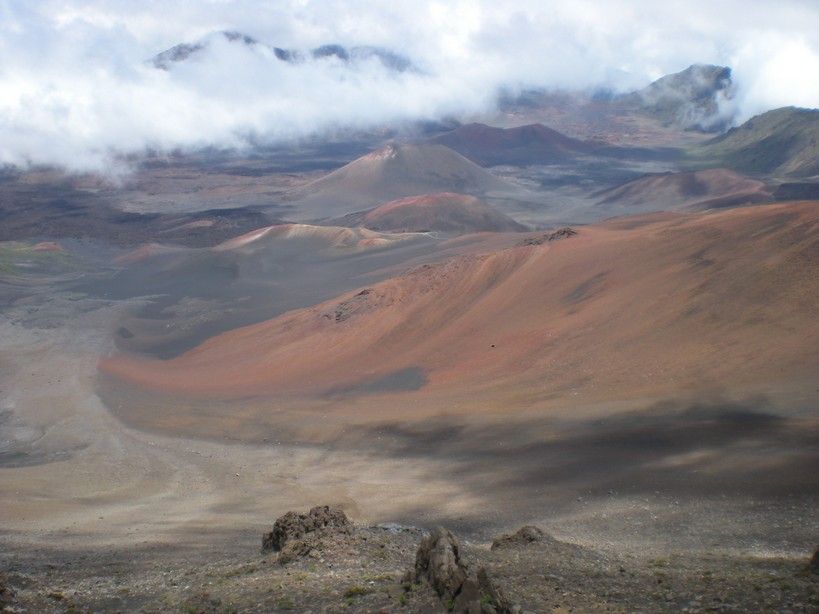
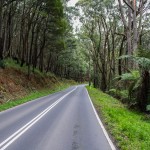
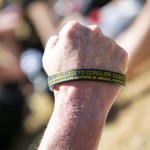
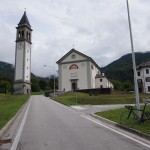
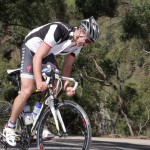
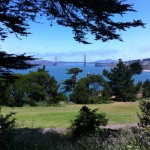
What did you think about the traffic on this route? I will be in the area in February and would love to tackle the climb, but the comments about no bike lanes and tight switchbacks seem a little sketchy regarding cars.
This Haleakala road biking is such an amusing experience. Yes as I know this one is longest sleep road biking track. I went there for my summer vacation last year, But I only ride 10km. I stopped because of the sleepy road. But for the professional, this is such a nice trail.
I just did the climb a few days ago. The fee is now 12$ and take both cash and credit as they change up the means of payment often, you don’t want to be stuck 3K below the summit!
I did the climb in May and the weather was cool and cloudy with threating weather, but leave early from PAIA, like 5:30-6am. I took a trash bag with head and arms cut out, as you can slide that under your jersey for the decent if needed.
Stop at Market just off the road Kaula market and use the potty, and refill the bottles, they are in the back of the market. You should have drank both large bottles by this time, if not chug a whole and refill both.
The final 22 miles are pretty exposed and if you left early the clouds will be chasing you up the climb, don’t dilly dally much at the market. About the 6K elevation mark the gradient levels some, this is a GREAT place to take in some solid food as you can eat and ride more easily at this point of the climb.
The pay station comes at about 7K, pay and ride up a bit farther to the visitors area, use the potty and refill both bottles that should be nearly empty. The final 3K of the climb is really exposed, and the winds can be strong. You will see the summit forever, keep it up. The final .5 miles are double-digit grade to the parking lot, continue up to the lookout point grab a photo, stretch and get ready for 1 hour of crazy decent back to the start.
BTW I’m the fattest fat guy (clydesdale up the climb 3:54) so just be ready and you can do it!
The last two years in Maui have been wet, the previous 15 dry. Rode yesterday (5/29/18) and was rained on the last 12 miles (6000 ft to the summit). So in addition to bringing warm gear, a gore-Tex riding jacket or some other rain-proof gear is highly recommended. Great ride, but last two hours were misery! To avoid going hypothermic, caught a ride with some nice German tourists back to Kula.
Just came back to Canada, having done this climb. Picked up some supplies and a jersey as well as some tips from this great shop. This may be of use to some, particularly with food/energy as everyone says to “bring food” but no one mentions how much. I’m a 135lb guy, with a carbon Giant TCR racing bike, with no real significant training for this ride and a moderate cycling schedule beforehand, and this is what I brought with me/did:
Decent breakfast at 4:30 am (oatmeal, banana etc), started ride at 6 am from Paia. Ate pretty healthy the day before.
4 protein/energy bars (one at the Kula market, another at the visitor center by the park entrance, and another at the summit visitor center…and a 4th somewhere in-between. 2 of them were Probar Superfood slam bars, more filling.) One of those 10 electrolyte tablet containers (went through 5-6) and started the ride with electrolytes in my water. Did not cramp up once.
4 packs of chews
4 gels
jersey/bib/windbreaker for the way up
rainjacket (bought at the store), wool base-layer, full fingered gloves, leg warmers, balaclava (it can get cold on the way down). I used all of this on the way down and was not cold at all. I’d read too many posts about people turning back due to weather to not be prepared.
Started with 2 full bottles, drank one by the time I reached Kula to fill at the back of the building, then drank 1.5 by the time I reached the park entrance/visitor station to fill, and had another 1.5 or so by the time I hit the summit.
Hope this helps, this was the most difficult thing I had ever done, but by far the most epic. Started at 6, and got down by 2:30, but had a fair amount of time at each visitor station as well as Kula market and at the summit.
Art
Just a follow up if anyone comes across this looking to do tackle this climb.. the fee is now $10 and only can be done via credit card.. lucky my friend brought his as i only had cash..
Did it 25 years ago. I still remember crossing the vegetation line around 7,000′ and how the rarefied air above that level turned it into a mental battle.
As I read this wonderful article, I’m flying over Haleakala on the way to Australia from Los Angeles. I feel the mountain calling my name again. It’s time. I hope to report back with a smile before the year is out.
Diablo is 10 miles and is HC rated by UCI
I’m trying to figure out my timing: If I climbed Mt. Diablo (Bay Area) in one hour and 30 minutes, is it reasonable to assume that Haleakala (36 miles) will take me 5 hours?
Great help. Did the climb 6/21/16. FWI for others, Sunrise market is permanently close so stop at Kula Market, park fee is now $10 for bike, no cash, credit card only, filtered water at lower visitors center near restroom entrance. Aloha
The entrance fee is now $10 – no big deal, but must be paid by credit card
So make sure you take your credit card if you have flown to Hawaii and ridden to 7000 feet!!
It might be worth adding the edit into the main article
Lucky I took mine
It is bloody hard so be well prepared
I did this 3 yrs ago on my 59th birthday in Aug. I took 7hr 15 min w quite a few bathroom and rest breaks due to an insanely uncomfortable seat on the rental. It hurt more than the climb and was felt going up Baldwin! I knew I was in for a bruising. More advise bring your own seat! I went up without using any cold GAR cause MY TESTING SHOWED I climb fastest at 55 degrees in the rain! Going down I stopped and took off all the cold gear and gloves cause it was slowing me down. I topped 20th gear even on the hairpins ( never done that and never was passed by any car until the ranger shack) 50+? So you can actually do this w out cold gear since you are generating core heat. Besides being an old person that obviously can barely generate 220 continuous watts I weigh 120lbs. The cold is only uncomfortable when you are off the bike. I think the seat made me want to get it over with more than cold comfort. Hear me, Mauna Kea can be deadly and the only reason I did not summit was 35 degrees and gale force winds at 6 PM that ripped my Montain bike from my hands. My wife could not bring my winter gear up since my 11yr old got oxy sickness higher than visitor center. Going down thegravel 20 f5 wide road full bore 20 percent grade sw8tch backs no air resistance ,was more fun than Haleakala. Even w full hypothermia ha. Recommend drive to visitor center and ride up then down. I rode bike from Ocean Hilo 14 hrs.
I am a mountain biker by heart although I do ride both road and MTB…….trying to decide which to bring to Maui with me…..road or MTB? I do plan on doing the 10k’ climb as well. 🙂
Great ride explanation. Just found this post on Google. I have never heard before about Haleakala
Completed the climb last week. This post is still a great resource. I was prepared for a great temperature/weather variation between base and summit, however, I found it was a pleasant 20C at the summit. Stopped twice for refuel/water at Kula Lodge and Park Visitor Center which breaks it up into roughly 1000 metre elevation gain segments.
Note that the Sunrise Market is now permanently closed and Kula Lodge seems to be the recommended first water point (22km from Paia).
I did it last week …. your article helped with being prepared..
and even though i took leg warmers, arm warmers, gilett and long finger gloves i still was freezing at the top and coming down was pretty unpleasant…
Very tough climb… i found it fairly ‘easy’ for the first 7000 feet, then it get hard, and the last 1000 feet gets kind of weird.
Very easy to under-estimate the food… we are talking 6 hours of riding including breaks…
Three bars and a gel or two was not enough.. i could have had a three gels for the last part…
Glad i did it though!
Wife and I went to Hawaii on a bike free holiday (boo). We got on a bus tour of Haleakala where they you bus up and have a bit of a tour (pretty cool \ unique environment and worth it) and then give you mountain bikes, a helmet and a map back to the shop. Probably the wrong web site to promote that (should be on the descendingcyclist.com ha ha) but gave me a good insight into what would be an absolute monster climb.
Did this ride on Sat jan26/14
started 7 in am , it took me about 5′ 30″ With couple Oj stops to wait for my partner in crime . We lucked out with the weather clean sky’s no wind . Ended riding the summit twice . Early by my selve, second time with my bike partner. Gar min said 10663′ elevation gain. We’ll worth the effort to ride. Pj wilson
Found this post on Google! I’m going to Maui next Sunday and I really want to do this ride. I’m not sure if I’ll make it to the summit but I sure as hell want to try and go as high as I can! Do you think the summit will still be as cold as you say at this time?
pls add me to your mailing list
Done!
Good stuff Frank. I used to love hill climbing around Tahoe. Makes me wanna get back on a bike…:)
Just when you thought this site couldn’t get any better, you get another gem like this. Fantastic writing, descriptions and advice. What more could you want other than a trip to Hawaii?
Thanks David! Agreed – Frank’s piece is great. Makes me want to go over there, that’s for sure!